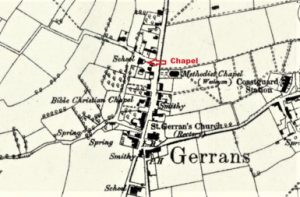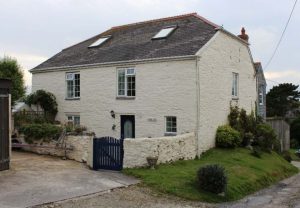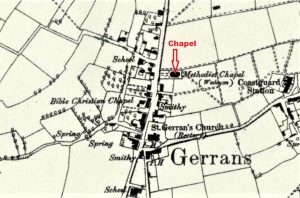
Gerrans is a coastal civil parish and village on the Roseland Peninsula in Cornwall. The village adjoins Portscatho (the villages have almost merged into one but retain their identities) on the east side of the peninsula. This profile of Gerrans Wesleyan Chapels has been compiled by Nev Meek of St Gerrans and Portscatho Old Cornwall Society.
Kowethas Kernow Goth – Gerens ha Porthskathow

The First Chapel
 Figure 1 1888 O.S. Six Inch Map
Figure 1 1888 O.S. Six Inch Map
In 1799 the Wesleyans formed a society at Gerrans, and leased land on Nampity Green from the Enys Estate, to build a preaching house on the site of a dilapidated house. The chapel was built of cob, with a half-hipped thatched roof. The chapel also had a gallery which faced away from the road; it is not known whether the gallery was part of the original construction, or whether it was installed at a later date. Initially the services were held monthly.
 Figure 2 2019 Gerrans Wesleyan Chapel 2 (St Gerrans & Portscatho OCS)
Figure 2 2019 Gerrans Wesleyan Chapel 2 (St Gerrans & Portscatho OCS)
In 1801 (1) the Episcopal Registrations for a licence includes “a house at Gerrance Churchtown.” It was registered by Richard Olive, Amos Collett, John Snell, William Pearce, Thomas Shepherd, Thomas Stodden, William Bullen, and Phillip Pearce. As of 1808 Gerrans was one of two Wesleyan chapels in Roseland within the St. Austell circuit, the other being at St Mawes. Services were held roughly on a monthly basis.
In 1810 the chapel was conveyed by those responsible for its construction to the trustees for the sum of 5 shillings. By 1818 the number of services had increased and by then were being held at 14.45hrs, on a weekly basis. In 1826 the chapel had 48 members, and by 1833 a total of 62 children attended the Sunday school.
At the beginning of 1841 the chapel had 53 members, however the revival of that year brought in an additional 62, bringing the total to 115. By 1844 the membership was 76.
The records show that over the succeeding years a really active and vibrant programme of activities developed which included: celebrations of religious festivals e.g., Easter & Christmas, celebrations of the chapel, and Sunday school anniversaries, harvest festival, and Sunday school tea treats.
By the mid-19th Century, the chapel was so successful that it was decided to build a new larger chapel; in 1869 the new chapel was built in Gerrans Churchtown on the opposite side of the road.
The First chapel, however, was retained and continued in active use primarily as a Sunday School, but was also used for tea meetings, concerts, meetings, jumble sales, bazaars etc., and on one occasion in 1887 was used for political meetings. It effectively became the village hall, and in 1921 the freehold was purchased.
In 1932 the Wesleyan Methodists and the United Methodists (including former Bible Christian Church) were merged. This effectively brought the 3 Gerrans chapels under a single authority; the former Bible Christian chapel with its school room then became the main Sunday school. By 1937 it was apparent that the first Wesleyan Chapel was surplus to requirements and it was sold to the Women’s Institute for £75. At the same time an outhouse was sold to Mr. C. Lobb for £10.
During WW2 the building was used as a school classroom due to the influx of evacuees into the village. Post war the building continued to be used by the Women’s Institute, and for occasional concerts. In 1949 the cricket field moved to its current location in Churchtown road, and the former chapel was used to provide tea for the players; the pavilion not being built until 1950/2.
In 1975 the chapel building was sold[2] by the Women’s Institute to private individuals and was subsequently converted to a dwelling. It currently continues in this usage.
The Second Chapel
 Figure 3 1888 OS Six inch Map showing Gerrans Wesleyan Methodist Chapel
Figure 3 1888 OS Six inch Map showing Gerrans Wesleyan Methodist Chapel
In 1869 the second chapel was built, at a cost of £750, in Gerrans Churchtown on a site acquired from the Enys Estate. It was built in the Gothic style, of local killas stone, with granite detailing. The new chapel seated 300 worshipers and rents for the pews paid for the upkeep of the building. It replaced the chapel on Nampity Green, which was used as a Sunday school.
Those responsible for the building work included: Ward, mason; Sawle, mason; Joseph Harris, mason; Oxenberry & Pearce, carpenter, joiner & glazier; Andain, blacksmith. Two hundred people attended the opening of the new chapel, when there was a public tea, followed by sermons and services. A path from “Stodden Steps” in Gerrans Hill led to the rear of the chapel. Historically there was a wrought iron sign over the steps reading “To the Wesleyan Chape
 Figure 4 2019 Gerrans Wesleyan Chapel © St Gerrans & Porthscatho OCS
Figure 4 2019 Gerrans Wesleyan Chapel © St Gerrans & Porthscatho OCS
In the 19th and early 20th Century Whitsuntide was a time of celebration in Gerrans with many sports events and parades. The St. Mawes Wesleyan Circuit held their quarterly meeting annually at Gerrans to coincide with these celebrations. As with the former chapel, all of the religious festivals were celebrated e.g., Easter & Christmas. The Harvest Festival, Chapel anniversary and Sunday School anniversary were important annual events. Other events such as bazaars and concerts were held. Money raised by these events went to pay off the chapel debt; contributions were also made to a variety of good causes including the Sailors’ Home at Falmouth, the local nursing association, and the Royal Cornwall Infirmary. The chapel arranged social outings, such as the visit to Caerhays gardens in 1912. There was a close association between the chapel and other local organisations such as the Band of Hope (a temperance society), and the Gerrans Friendly Society (a self-help organisation).
In terms of social history, these chapels were extremely important. The general population were becoming more educated, and the chapels provided an opportunity for people to become involved in supporting their communities. There were a range of administrative roles – secretaries, treasurers, stewards etc.; in addition, the chapels relied on a system of local lay preachers who led most services. The role of women was important ranging from organising events to playing musical instruments; they were often the organisational powerhouse supporting the chapel.
In 1880 the Wesleyan Sunday School Centenary celebrations in the Roseland was centred on Gerrans. About 557 children from the Sunday Schools at St Mawes, St Just, Gerrans, St Anthony, Treworlas, Ruan Lanihorne, Trewartha (Veryan), Portholland all travelled to Gerrans. Headed by a brass band they paraded around Portscatho and Gerrans. A public tea fed about 650 people, and a sports event took place in a nearby field. In total 2,000 people took part in the celebrations.
In 1889 the chapel was registered for conducting marriages, and probably the first marriage took place in the August.
In 1912 an evangelist event was held by Mr. J. Joliff, the fisherman evangelist of Polperro. It lasted 12 days and 29 new members were recruited. However, membership decreased in the period after WW1. In 1932 the Wesleyan Methodists merged with the United Methodists (including the former Bible Christian Church). This effectively merged Wesley with Zion! Both chapels were used for a period with services at Zion in the morning and at the former Wesleyan Chapel in the evening. In 1936 the use of the 3 chapels was re-assessed. The original old Wesleyan chapel was sold. The former Bible Christian Chapel “Zion” was then used as the Sunday School, and the former Wesleyan Chapel used for services.
On amalgamation in 1932 there were 50 chapel members but this decreased during the latter half of the 20th Century so that there were 22 members in 1950, 18 in 1978, and just 5 with 5 attendees by 1987 when the chapel closed. The chapel merged with the United Reform Church, and the Wesleyan Chapel was sold. A proportion of the money raised was used for the refurbishment of Portscatho Congregational Church.[3] Remaining members of the congregation transferred to Portscatho.
The former chapel was converted to two dwellings which are now used for holiday accommodation.
Nev Meek (Recorder): nev.meek@sky.com
www.stgandpocs.co.uk
www.facebook.com/gerransoldcornwall
www.twitter.com/GerransSt
St Gerrans & Porthscatho Old Cornwall Society is affiliated to the Federation of Old Cornwall Societies – Registered Charity No.247283.
1 Note: Beckerlegge gives the year as 1806
2 Gerrans Parish Memorial Hall had been built a number of years previous rendering the former chapel surplus to requirements.
3 Now Portscatho United Church
